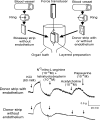Endothelium-dependent contractions: when a good guy turns bad!
- PMID: 18818246
- PMCID: PMC2655387
- DOI: 10.1113/jphysiol.2008.161430
Endothelium-dependent contractions: when a good guy turns bad!
Abstract
Endothelial cells can induce contractions of the underlying vascular smooth muscle by generating vasoconstrictor prostanoids (endothelium-dependent contracting factor; EDCF). The endothelial COX-1 isoform of cyclooxygenase appears to play the dominant role in the phenomenon. Its activation requires an increase in intracellular Ca(2+) concentration. The production of EDCF is inhibited acutely and chronically by nitric oxide (NO), and possibly by endothelium-dependent hyperpolarizing factor (EDHF). The main prostanoids involved in endothelium-dependent contractions appear to be endoperoxides (PGH(2)) and prostacyclin, which activate thromboxane-prostanoid (TP) receptors of the vascular smooth muscle cells. Oxygen-derived free radicals can facilitate the production and/or the action of EDCF. Endothelium-dependent contractions are exacerbated by ageing, obesity, hypertension and diabetes, and thus are likely to contribute to the endothelial dysfunction observed in older people and in essential hypertensive patients.
Figures




References
-
- Abeywardena MY, Jablonskis LT, Head RJ. Age- and hypertension-induced changes in abnormal contractions in rat aorta. J Cardiovasc Pharmacol. 2002;40:930–937. - PubMed
-
- Álvarez Y, Briones AM, Balfagón G, Alonso MJ, Salaices M. Hypertension increases the participation of vasoconstrictor prostanoids from cyclooxygenase-2 in phenylephrine responses. J Hypertens. 2005;23:767–777. - PubMed
-
- Asano H, Shimizu K, Muramatsu M, Iwama Y, Toki Y, Miyazaki Y, Okumura K, Hashimoto H, Ito T. Prostaglandin H2 as an endothelium-derived contracting factor modulates endothelin-1-induced contraction. J Hypertens. 1994;12:383–390. - PubMed
-
- Auch-Schwelk W, Katusic ZS, Vanhoutte PM. Contractions to oxygen-derived free radicals are augmented in aorta of the spontaneously hypertensive rat. Hypertension. 1989;13:859–864. - PubMed
Publication types
MeSH terms
Substances
LinkOut - more resources
Full Text Sources
Research Materials
Miscellaneous

